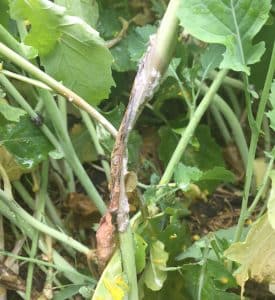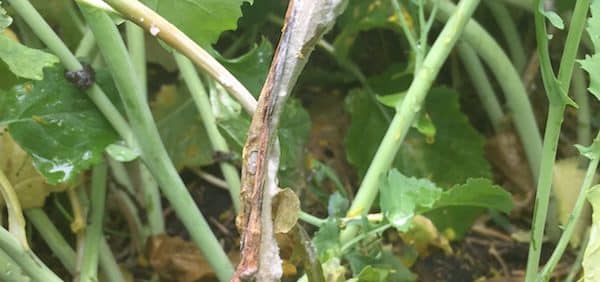Sclerotinia stem rot will likely occur if a field has regular rains or high humidity or both from two to three weeks before flowering and through flowering. This will get spore-releasing apothecia going in time to be active during flowering, dispersing spores on petals (and everywhere else in the canopy). If moist conditions continue after flowering, severity of the disease could be high and yield loss significant.
With these conditions and yield potential of 30 bu./ac. or greater, a fungicide application at 20-30% flower is warranted.
On the other hand, if conditions were dry in the two or three weeks before the crop reaches 20% flower and the crop canopy is thin and open, economic return for a fungicide application is not likely.

Unfortunately the decision to spray or not spray is not usually as clear as these two examples suggest. Consider the following three scenarios:
Scenario 1. Good early season growth but hot, dry weather through flowering
This should reduce the risk of heavy sclerotinia infection even if moist weather earlier promoted a lot of apothecia emergence and spore release. Keep in mind however that “moisture” to promote sclerotinia does not have to be rainfall. How dry is it really? Humid weather that leads to morning dew and a humid canopy can promote the disease. Even on hot days, if moisture and humidity are abundant through the canola canopy, it may be worthwhile spraying. Keep in mind that even though the sclerotinia fungus does not like to grow over temperatures of 30°C, night temperatures are often lower and will allow for fungal growth.
In this scenario, note that hot weather during flowering can increase flower and pod abortion and reduce overall yield potential. And hot, dry weather during pod fill and ripening reduces the progression of sclerotinia within the plant.
Scenario 2: Rainfall is below average, but it has rained
Rainfall is less than average but there have been rains and there is moisture deep in the canopy. Do you spray for disease?
Canopy moisture and humidity are key and it may not take much rain to cause infection. Even if the farm has been fairly dry over the past two weeks, if moisture was moderate to ample leading up to canopy cover, the situation for spore release will be there. If pants get wet from dew while walking through the canopy each morning, this indicates a moist canopy environment. A petal test to identify the presence of spores may help with the decision.
Field history is a factor. With a field history of sclerotinia, the inclination would be to spray unless weather conditions are very dry and yield outlook is low.
Watch the weather forecast. If repeated showers during flowering extend the flowering period, a second application may be needed and sometimes provided better control than the first application of fungicide. Or if conditions pre-flower were too dry for disease but changed in flower, a late window application may pay off – especially if moisture greatly extends the full-flower period.
Scenario 3: Dry early, now moist
Moisture in the two weeks before flowering, during flowering and in the two weeks after flowering may create prime conditions for heavy sclerotinia stem rot infection. If conditions were dry, then turned wet, the sclerotinia risk depends on when this transition occurred.
It takes 14 to 21 days of continuous soil moisture (in the top layer of the soil) to move the sclerotinia cycle from sclerotia germination to apothecia emergence to spore release. A humid closed canopy is often enough. Continued rainfall is not always necessary as long as soil was moistened and stays moist, resulting in humid conditions within the crop canopy. A dense crop canopy can hold in moisture and create conducive conditions for disease development.
If moisture comes closer to flowering, the highest risk for disease development could occur later in the flowering period. This may justify a spray at 30-50% flower (late window) instead of 20-30% flower (early window).
Further reading:
Canola Watch quiz – sclerotinia spray decision
Sclerotinia stem rot checklist
Sclerotinia stem rot: Risk factors and spray timing
Quick comparison: Blackleg, clubroot and sclerotinia stem rot
Sclerotinia petal test
Sclerotinia stem rot management (detailed article)

